Deck 51: An Overview of Ecology
Question
Question
Question
Question
Question
Question
Question
Question
Question
Question
Question
Question
Question
Question
Question
Question
Question
Question
Question
Question
Question
Question
Question
Question
Question
Question
Question
Question
Question
Question
Question
Question
Question
Question
Question
Question
Question
Question
Question
Question
Question
Question
Question
Question
Question
Question
Question
Question
Question
Question
Question
Question
Question
Question
Question
Question
Question
Question
Question
Question
Question
Question
Question
Question
Question
Question
Question
Question
Question
Question
Question

Unlock Deck
Sign up to unlock the cards in this deck!
Unlock Deck
Unlock Deck
1/71
Play
Full screen (f)
Deck 51: An Overview of Ecology
1
Which of the following investigations would provide the most informative data to use for predicting the future distribution of organisms in temperate regions that are faced with climate change?
A) Remove, to the mineral soil, all of the organisms from an experimental plot, and monitor the colonization of the area over time in terms of both species diversity and abundance.
B) Look at the climatic changes that occurred since the last ice age and how species redistributed as glaciers melted.
C) Compare and contrast the flora and fauna of warm/cold/dry/wet climates to shed light on how they evolved to be suited to their present-day environment.
D) Quantify the impact of human activities on present-day populations of threatened and endangered species to assess the rate of range contraction, expansion, or extinction.
A) Remove, to the mineral soil, all of the organisms from an experimental plot, and monitor the colonization of the area over time in terms of both species diversity and abundance.
B) Look at the climatic changes that occurred since the last ice age and how species redistributed as glaciers melted.
C) Compare and contrast the flora and fauna of warm/cold/dry/wet climates to shed light on how they evolved to be suited to their present-day environment.
D) Quantify the impact of human activities on present-day populations of threatened and endangered species to assess the rate of range contraction, expansion, or extinction.
B
2
Generally, deserts are located in places where air masses are which of the following?
A) tropical
B) ascending
C) at the start of trade winds
D) descending
A) tropical
B) ascending
C) at the start of trade winds
D) descending
D
3
For mountain ranges that are subjected to prevailing winds, which of the following best explains why is the climate drier on the leeward (downwind) side?
A) Deserts create dry conditions on the leeward side of mountain ranges.
B) The sun illuminates the leeward side of mountain ranges at a more direct angle, converting to heat energy, which evaporates most of the water present.
C) Pushed by the prevailing winds on the windward side, air is forced to rise, cool, condense, and drop its precipitation, leaving drier air to descend the leeward side.
D) Air masses pushed by the prevailing winds are stopped by mountain ranges and the moisture is used up in the stagnant air masses on the leeward side.
A) Deserts create dry conditions on the leeward side of mountain ranges.
B) The sun illuminates the leeward side of mountain ranges at a more direct angle, converting to heat energy, which evaporates most of the water present.
C) Pushed by the prevailing winds on the windward side, air is forced to rise, cool, condense, and drop its precipitation, leaving drier air to descend the leeward side.
D) Air masses pushed by the prevailing winds are stopped by mountain ranges and the moisture is used up in the stagnant air masses on the leeward side.
C
4
In the region of the Rocky Mountains, one local variety of Ponderosa pine (Pinus ponderosa) predominantly occurs between 5,000 and 8,500 feet in elevation, where it can best tolerate temperatures and precipitation. Which of the following changes in pine tree range is most likely to result if future climate change in this region causes the temperature to increase and rainfall to decrease?
A) that variety will occur at lower elevations
B) that variety will occur at higher elevations
C) that variety will occur at lower elevations and/or lower latitudes
D) that variety will occur at higher elevations and/or higher latitudes
A) that variety will occur at lower elevations
B) that variety will occur at higher elevations
C) that variety will occur at lower elevations and/or lower latitudes
D) that variety will occur at higher elevations and/or higher latitudes

Unlock Deck
Unlock for access to all 71 flashcards in this deck.
Unlock Deck
k this deck
5
What is most likely to happen to the seasons if Earth were tilted 35 degrees off its orbital plane instead of the usual 23.5 degrees?
A) The seasons would disappear.
B) Winters and summers would be more severe.
C) Winters and summers would be less severe.
D) The seasons would be shorter.
A) The seasons would disappear.
B) Winters and summers would be more severe.
C) Winters and summers would be less severe.
D) The seasons would be shorter.

Unlock Deck
Unlock for access to all 71 flashcards in this deck.
Unlock Deck
k this deck
6
Which of the following is the most likely effect on climate in the temperate latitudes if Earth were to slow its rate of rotation from a 24-hour period of rotation to a 48-hour period of rotation?
A) Seasons would be longer and more distinct (colder winters and warmer summers).
B) Large-scale weather events such as tornadoes and hurricanes would no longer be a part of regional climates.
C) Winter seasons in both the northern and southern hemispheres would have more abundant and frequent precipitation events.
D) There often would be a larger range between daytime high and nighttime low temperatures.
A) Seasons would be longer and more distinct (colder winters and warmer summers).
B) Large-scale weather events such as tornadoes and hurricanes would no longer be a part of regional climates.
C) Winter seasons in both the northern and southern hemispheres would have more abundant and frequent precipitation events.
D) There often would be a larger range between daytime high and nighttime low temperatures.

Unlock Deck
Unlock for access to all 71 flashcards in this deck.
Unlock Deck
k this deck
7
Which of the following explains why seasonal changes, for example, in temperature and/or precipitation, are greater at middle to high latitudes than seasonal changes at equatorial latitudes?
A) the variation in proximity of the Earth to the sun is less drastic at the equator
B) the angle of Earth's axis with respect to the plane of its orbit around the sun causes solar rays to vary the most within the year at mid-latitudes
C) the microclimates at middle and low latitudes are more variable than at the equator
D) the yearly wobble of Earth's tilt causes higher latitudes to fluctuate, while the equator remains stable
A) the variation in proximity of the Earth to the sun is less drastic at the equator
B) the angle of Earth's axis with respect to the plane of its orbit around the sun causes solar rays to vary the most within the year at mid-latitudes
C) the microclimates at middle and low latitudes are more variable than at the equator
D) the yearly wobble of Earth's tilt causes higher latitudes to fluctuate, while the equator remains stable

Unlock Deck
Unlock for access to all 71 flashcards in this deck.
Unlock Deck
k this deck
8
North-facing slopes in mountainous areas of western North America would be expected to ________.
A) receive more sunlight than similar southern exposures
B) be warmer and drier than comparable southern-exposed slopes
C) support biological communities similar to those found at lower elevations on similar south-facing slopes
D) support biological communities similar to those found at higher elevations on similar south-facing slopes
A) receive more sunlight than similar southern exposures
B) be warmer and drier than comparable southern-exposed slopes
C) support biological communities similar to those found at lower elevations on similar south-facing slopes
D) support biological communities similar to those found at higher elevations on similar south-facing slopes

Unlock Deck
Unlock for access to all 71 flashcards in this deck.
Unlock Deck
k this deck
9
Which of the following best represents an investigation of the concept of a microclimate?
A) the effect of ambient temperature on the global loss of coral reefs
B) the seasonal population fluctuation of nurse sharks in coral reef communities
C) competitive interactions among various species of songbirds during spring migration
D) how sunlight intensity affects plant community composition in the transition zone between a forest and a meadow
A) the effect of ambient temperature on the global loss of coral reefs
B) the seasonal population fluctuation of nurse sharks in coral reef communities
C) competitive interactions among various species of songbirds during spring migration
D) how sunlight intensity affects plant community composition in the transition zone between a forest and a meadow

Unlock Deck
Unlock for access to all 71 flashcards in this deck.
Unlock Deck
k this deck
10
At 15-30°N, air masses formed over the Pacific Ocean are moved by prevailing westerlies, where they encounter extensive north-south mountain ranges over continents. Which statement best describes the result when an air mass encounters a landform?
A) The cool, moist Pacific air heats as it rises, releasing its precipitation as it passes the tops of the mountains. This now warm and dry air cools as it descends on the leeward side of the range.
B) The warm, moist Pacific air rises and cools, releasing precipitation as it moves up the windward side of the range. This now cool and dry air mass heats up as it descends on the leeward side of the range.
C) The cool, dry Pacific air heats up and picks up moisture from evaporation of the snowcapped peaks of the mountain range, releasing this moisture as precipitation when the air cools while descending on the leeward side of the range.
D) These air masses are blocked by the mountain ranges, producing high annual amounts of precipitation on the windward sides of these mountain ranges.
A) The cool, moist Pacific air heats as it rises, releasing its precipitation as it passes the tops of the mountains. This now warm and dry air cools as it descends on the leeward side of the range.
B) The warm, moist Pacific air rises and cools, releasing precipitation as it moves up the windward side of the range. This now cool and dry air mass heats up as it descends on the leeward side of the range.
C) The cool, dry Pacific air heats up and picks up moisture from evaporation of the snowcapped peaks of the mountain range, releasing this moisture as precipitation when the air cools while descending on the leeward side of the range.
D) These air masses are blocked by the mountain ranges, producing high annual amounts of precipitation on the windward sides of these mountain ranges.

Unlock Deck
Unlock for access to all 71 flashcards in this deck.
Unlock Deck
k this deck
11
Which of the following is the cause of generalized global air circulation and precipitation patterns?
A) solar radiation that warms moist air masses near the equator, which then cool and release precipitation as they rise, and then, at high altitude, move north or south of the tropics and sink back to the surface as dry air masses
B) air masses that are dried and heated over continental areas, which then rise, cool aloft, and descend over oceanic areas, followed by a return flow of moist air from ocean to land, delivering high amounts of precipitation to coastal areas
C) polar, cool, moist, high-pressure air masses from the poles that move along the surface, releasing precipitation along the way to the equator, where they are heated and dried
D) solar radiation that warms dry air masses at the poles, causing them to sink toward the tropics, gain moisture, and then release it as precipitation
A) solar radiation that warms moist air masses near the equator, which then cool and release precipitation as they rise, and then, at high altitude, move north or south of the tropics and sink back to the surface as dry air masses
B) air masses that are dried and heated over continental areas, which then rise, cool aloft, and descend over oceanic areas, followed by a return flow of moist air from ocean to land, delivering high amounts of precipitation to coastal areas
C) polar, cool, moist, high-pressure air masses from the poles that move along the surface, releasing precipitation along the way to the equator, where they are heated and dried
D) solar radiation that warms dry air masses at the poles, causing them to sink toward the tropics, gain moisture, and then release it as precipitation

Unlock Deck
Unlock for access to all 71 flashcards in this deck.
Unlock Deck
k this deck
12
After glaciers melt and shrink in size, the ability of plants to extend their range and reach un-vegetated regions is initially determined by which of the following?
A) whether there is simultaneous migration of herbivores
B) their tolerance to shade
C) their seed dispersal rate
D) their tolerance to cooler temperatures
A) whether there is simultaneous migration of herbivores
B) their tolerance to shade
C) their seed dispersal rate
D) their tolerance to cooler temperatures

Unlock Deck
Unlock for access to all 71 flashcards in this deck.
Unlock Deck
k this deck
13
As temperatures rise due to global climate change, plant species' ranges in the southern hemisphere may move further southward. Which of the following is a characteristic of plants that would most likely allow them to avoid extinction by moving southward under climate change?
A) those having larger, and initially more contiguous, established populations
B) those having smaller established populations
C) those having seeds that become viable only after a forest fire
D) those which disperse many seeds in close proximity to the parent tree
A) those having larger, and initially more contiguous, established populations
B) those having smaller established populations
C) those having seeds that become viable only after a forest fire
D) those which disperse many seeds in close proximity to the parent tree

Unlock Deck
Unlock for access to all 71 flashcards in this deck.
Unlock Deck
k this deck
14
In creating global climate patterns, which of the following factors is most likely the primary cause of all of the other factors that are listed?
A) precipitation differences between tropical and polar regions
B) global ocean currents
C) global wind patterns
D) variation in the heating of Earth's surface
A) precipitation differences between tropical and polar regions
B) global ocean currents
C) global wind patterns
D) variation in the heating of Earth's surface

Unlock Deck
Unlock for access to all 71 flashcards in this deck.
Unlock Deck
k this deck
15
Coral reefs occur on the southeast coast of the United States, near Florida, but not at similar latitudes on the southwest coast near Los Angeles. Differences in which of the following most likely account for this?
A) air temperatures driven by precipitation
B) day length
C) water temperatures driven by ocean currents
D) marine salinity differences
A) air temperatures driven by precipitation
B) day length
C) water temperatures driven by ocean currents
D) marine salinity differences

Unlock Deck
Unlock for access to all 71 flashcards in this deck.
Unlock Deck
k this deck
16
Which of the following causes seasons to occur on Earth?
A) the variation in proximity of the Earth to the sun at different times of the year
B) the angle of Earth's axis with respect to the sun, combined with its orbit around the sun
C) the distance between the Earth and the sun in winter versus in the summer
D) the variation or wobble of Earth's tilt during the year
A) the variation in proximity of the Earth to the sun at different times of the year
B) the angle of Earth's axis with respect to the sun, combined with its orbit around the sun
C) the distance between the Earth and the sun in winter versus in the summer
D) the variation or wobble of Earth's tilt during the year

Unlock Deck
Unlock for access to all 71 flashcards in this deck.
Unlock Deck
k this deck
17
If an ecologist were studying the regional interactions among multiple populations of different species, and how they influence the exchange of materials between their various environments, which of the following best represents this scale of research?
A) landscape ecology
B) population ecology
C) global ecology
D) ecosystem ecology
A) landscape ecology
B) population ecology
C) global ecology
D) ecosystem ecology

Unlock Deck
Unlock for access to all 71 flashcards in this deck.
Unlock Deck
k this deck
18
Subtropical plants are commonplace in Land's End, England, however, at the equivalent latitude of Labrador in coastal Canada, the local flora is instead subarctic. Which statement best explains why this apparent anomaly exists between North America and Europe?
A) Labrador does not get enough rainfall to support the subtropical flora found in Land's End.
B) Warm ocean currents interact with England, whereas cold ocean currents interact with Labrador.
C) Rainfall fluctuates greatly in England; rainfall is consistently high in Labrador.
D) Labrador receives sunlight of lower duration and intensity than does Land's End.
A) Labrador does not get enough rainfall to support the subtropical flora found in Land's End.
B) Warm ocean currents interact with England, whereas cold ocean currents interact with Labrador.
C) Rainfall fluctuates greatly in England; rainfall is consistently high in Labrador.
D) Labrador receives sunlight of lower duration and intensity than does Land's End.

Unlock Deck
Unlock for access to all 71 flashcards in this deck.
Unlock Deck
k this deck
19
The main reason polar regions are cooler than the equator is that ________.
A) solar radiation strikes the poles at a lower angle and travels through more atmosphere
B) the poles are farther from the sun than is the equator
C) the polar atmosphere is thinner and contains fewer greenhouse gases
D) the poles are permanently tilted away from the sun
A) solar radiation strikes the poles at a lower angle and travels through more atmosphere
B) the poles are farther from the sun than is the equator
C) the polar atmosphere is thinner and contains fewer greenhouse gases
D) the poles are permanently tilted away from the sun

Unlock Deck
Unlock for access to all 71 flashcards in this deck.
Unlock Deck
k this deck
20
Which of the following would be the most likely result if the Earth's axis were perpendicular to the orbital plane between Earth and the sun?
A) the elimination of tides
B) an increase in the length of a year
C) a decrease in temperature at the equator
D) the elimination of seasonal variation
A) the elimination of tides
B) an increase in the length of a year
C) a decrease in temperature at the equator
D) the elimination of seasonal variation

Unlock Deck
Unlock for access to all 71 flashcards in this deck.
Unlock Deck
k this deck
21
The eight panels below show average climatic values across the year on a monthly basis, as represented by first letter of each month depicted on the x-axis. Temperature values are depicted as a line graph and represented by the left vertical axis, while precipitation values are depicted as a bar graph and represented by the right vertical axis.  Which panel (A-H) most likely depicts the climate for location 4 as shown on the map in the center panel?
Which panel (A-H) most likely depicts the climate for location 4 as shown on the map in the center panel?
A) A
B) C
C) E
D) G
 Which panel (A-H) most likely depicts the climate for location 4 as shown on the map in the center panel?
Which panel (A-H) most likely depicts the climate for location 4 as shown on the map in the center panel?A) A
B) C
C) E
D) G

Unlock Deck
Unlock for access to all 71 flashcards in this deck.
Unlock Deck
k this deck
22
The eight panels below show average climatic values across the year on a monthly basis, as represented by first letter of each month depicted on the x-axis. Temperature values are depicted as a line graph and represented by the left vertical axis, while precipitation values are depicted as a bar graph and represented by the right vertical axis. 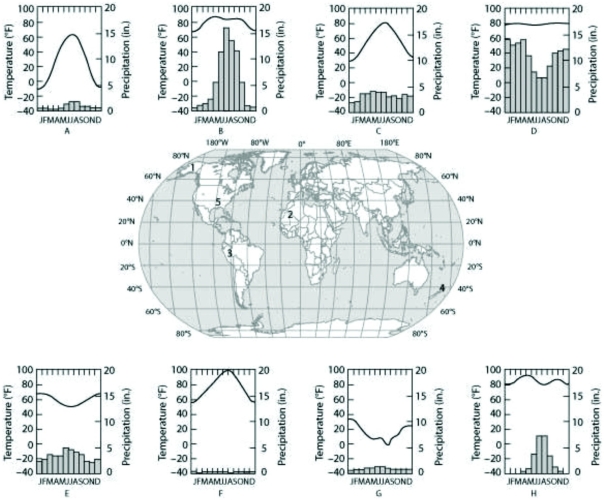 Which panel (A-H) most likely depicts the climate for location 5 as shown on the map in the center panel?
Which panel (A-H) most likely depicts the climate for location 5 as shown on the map in the center panel?
A) A
B) B
C) D
D) H
 Which panel (A-H) most likely depicts the climate for location 5 as shown on the map in the center panel?
Which panel (A-H) most likely depicts the climate for location 5 as shown on the map in the center panel?A) A
B) B
C) D
D) H

Unlock Deck
Unlock for access to all 71 flashcards in this deck.
Unlock Deck
k this deck
23
Which of the following is an important feature of most terrestrial biomes?
A) annual average rainfall in excess of 250 cm
B) a distribution predicted almost entirely by rock and soil patterns
C) clear boundaries between adjacent biomes
D) vegetation demonstrating vertical layering
A) annual average rainfall in excess of 250 cm
B) a distribution predicted almost entirely by rock and soil patterns
C) clear boundaries between adjacent biomes
D) vegetation demonstrating vertical layering

Unlock Deck
Unlock for access to all 71 flashcards in this deck.
Unlock Deck
k this deck
24
Which type of biome is best defined by the following characteristics?
∙ conifers are very prevalent, as well as pines and spruce trees
∙ one of the largest biomes in terms of square kilometers of area
∙ does not receive a lot of precipitation, but is still very moist because of the presence of permafrost
A) boreal forest
B) temperate evergreen forest
C) tundra
D) temperate deciduous forest
∙ conifers are very prevalent, as well as pines and spruce trees
∙ one of the largest biomes in terms of square kilometers of area
∙ does not receive a lot of precipitation, but is still very moist because of the presence of permafrost
A) boreal forest
B) temperate evergreen forest
C) tundra
D) temperate deciduous forest

Unlock Deck
Unlock for access to all 71 flashcards in this deck.
Unlock Deck
k this deck
25
Which of the following statements best describes the interaction between fire and ecosystems?
A) The likelihood of a wildfire occurring in a given ecosystem is highly predictable over the short term.
B) Many kinds of plants and plant communities have adapted to frequent fires.
C) The suppression of forest fires by humans has prevented certain communities, such as grasslands, from reaching their climax stage.
D) Chaparral communities have evolved to the extent that they rarely burn.
A) The likelihood of a wildfire occurring in a given ecosystem is highly predictable over the short term.
B) Many kinds of plants and plant communities have adapted to frequent fires.
C) The suppression of forest fires by humans has prevented certain communities, such as grasslands, from reaching their climax stage.
D) Chaparral communities have evolved to the extent that they rarely burn.

Unlock Deck
Unlock for access to all 71 flashcards in this deck.
Unlock Deck
k this deck
26
Use the following figures to answer the question below. The figure depicts average temperatures and total precipitation across the 12 months of the year. Annual precipitation in Area 1 is approximately 260 cm, and in Area 2, 10 cm.  Based on the data in the figures, which of the following statements is most consistent with the data?
Based on the data in the figures, which of the following statements is most consistent with the data?
A) Area 1 is considered a hot desert because of its high average temperature, and it also has higher average precipitation than Area 2.
B) Area 1 has higher average precipitation than Area 2, and also has a larger annual temperature variation.
C) Area 2 is considered taiga.
D) Area 2 has a larger annual temperature variation, and it is considered a hot desert due to its low annual precipitation.
 Based on the data in the figures, which of the following statements is most consistent with the data?
Based on the data in the figures, which of the following statements is most consistent with the data?A) Area 1 is considered a hot desert because of its high average temperature, and it also has higher average precipitation than Area 2.
B) Area 1 has higher average precipitation than Area 2, and also has a larger annual temperature variation.
C) Area 2 is considered taiga.
D) Area 2 has a larger annual temperature variation, and it is considered a hot desert due to its low annual precipitation.

Unlock Deck
Unlock for access to all 71 flashcards in this deck.
Unlock Deck
k this deck
27
Hot deserts are characterized by which of the following features?
A) Low water availability as an important constraint on the abundance of desert plants.
B) They are usually located within 10 degrees of the equator.
C) Plants tall in stature with large leaves
D) Moderate to high water availability in only some months of the year.
A) Low water availability as an important constraint on the abundance of desert plants.
B) They are usually located within 10 degrees of the equator.
C) Plants tall in stature with large leaves
D) Moderate to high water availability in only some months of the year.

Unlock Deck
Unlock for access to all 71 flashcards in this deck.
Unlock Deck
k this deck
28
The eight panels below show average climatic values across the year on a monthly basis, as represented by first letter of each month depicted on the x-axis. Temperature values are depicted as a line graph and represented by the left vertical axis, while precipitation values are depicted as a bar graph and represented by the right vertical axis.  What is the primary factor other than precipitation or temperature that could change the description of a site near location 3 from an equatorial (tropical) climate to alpine tundra?
What is the primary factor other than precipitation or temperature that could change the description of a site near location 3 from an equatorial (tropical) climate to alpine tundra?
A) ocean currents
B) soil type
C) elevation
D) rain shadow
 What is the primary factor other than precipitation or temperature that could change the description of a site near location 3 from an equatorial (tropical) climate to alpine tundra?
What is the primary factor other than precipitation or temperature that could change the description of a site near location 3 from an equatorial (tropical) climate to alpine tundra?A) ocean currents
B) soil type
C) elevation
D) rain shadow

Unlock Deck
Unlock for access to all 71 flashcards in this deck.
Unlock Deck
k this deck
29
Which of the following biomes spans the largest annual mean precipitation range and the narrowest annual mean temperature range?
A) tropical forest
B) temperate forest
C) desert
D) taiga
A) tropical forest
B) temperate forest
C) desert
D) taiga

Unlock Deck
Unlock for access to all 71 flashcards in this deck.
Unlock Deck
k this deck
30
Which of the following sources of information allows us to most accurately predict and draw the boundaries of Earth's biomes?
A) the physiological constraints of the environment on animals found within the region
B) the taxonomic similarities among animal life found within the region
C) the geographic location of the biomes on the planet
D) the precipitation and temperature constraints on vegetation within the biome
A) the physiological constraints of the environment on animals found within the region
B) the taxonomic similarities among animal life found within the region
C) the geographic location of the biomes on the planet
D) the precipitation and temperature constraints on vegetation within the biome

Unlock Deck
Unlock for access to all 71 flashcards in this deck.
Unlock Deck
k this deck
31
The eight panels below show average climatic values across the year on a monthly basis, as represented by first letter of each month depicted on the x-axis. Temperature values are depicted as a line graph and represented by the left vertical axis, while precipitation values are depicted as a bar graph and represented by the right vertical axis. 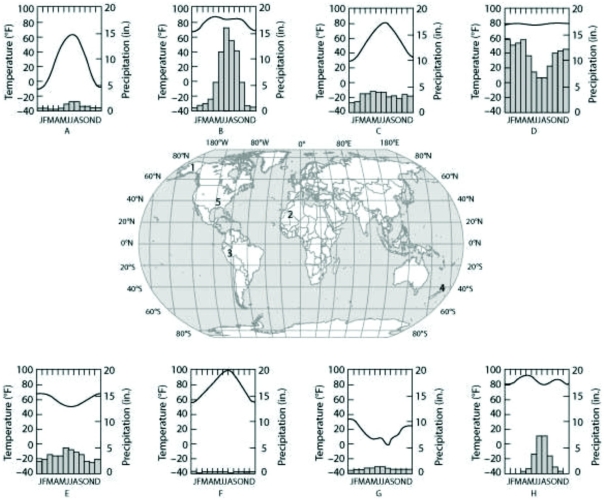 Which panel (A-H) most likely depicts the climate for location 2 as shown on the map in the center panel?
Which panel (A-H) most likely depicts the climate for location 2 as shown on the map in the center panel?
A) C
B) D
C) F
D) H
 Which panel (A-H) most likely depicts the climate for location 2 as shown on the map in the center panel?
Which panel (A-H) most likely depicts the climate for location 2 as shown on the map in the center panel?A) C
B) D
C) F
D) H

Unlock Deck
Unlock for access to all 71 flashcards in this deck.
Unlock Deck
k this deck
32
The transitions in biological communities with increasing elevation are most analogous to the changes seen in which of the following?
A) in biomes at different latitudes
B) in a community through different seasons
C) in an ecosystem as it evolves over time
D) across the United States from east to west
A) in biomes at different latitudes
B) in a community through different seasons
C) in an ecosystem as it evolves over time
D) across the United States from east to west

Unlock Deck
Unlock for access to all 71 flashcards in this deck.
Unlock Deck
k this deck
33
Use the following figures to answer the question below. The figure depicts average temperatures and total precipitation across the 12 months of the year. Annual precipitation in Area 1 is approximately 260 cm, and in Area 2, 10 cm. 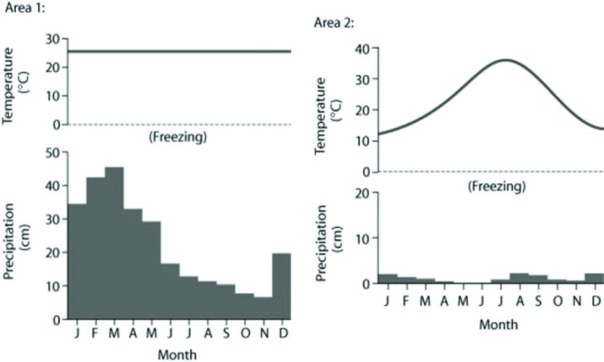 Based on the data in the figures, which of the following statements is most consistent with the data?
Based on the data in the figures, which of the following statements is most consistent with the data?
A) Area 1 is considered a fall-wet system.
B) Area 1 is near or in the tropics.
C) Area 1 is in mid-continental boreal forest.
D) Area 2 is in the arctic.
 Based on the data in the figures, which of the following statements is most consistent with the data?
Based on the data in the figures, which of the following statements is most consistent with the data?A) Area 1 is considered a fall-wet system.
B) Area 1 is near or in the tropics.
C) Area 1 is in mid-continental boreal forest.
D) Area 2 is in the arctic.

Unlock Deck
Unlock for access to all 71 flashcards in this deck.
Unlock Deck
k this deck
34
Which of the following best explains why the actual vegetation that is present in a particular biome may not match the prediction of a global biome map that was generated by modeling the temperatures and precipitation expected at a given latitude?
A) precipitation and temperature are not the primary factors which control vegetative growth
B) biomes overlap with one another so you can not ever be sure what to expect
C) the Earth's tilt has resulted in seasonal changes that impact biomes
D) local differences in soil, elevation, or topography can result in considerably different climates and plant communities within a biome
A) precipitation and temperature are not the primary factors which control vegetative growth
B) biomes overlap with one another so you can not ever be sure what to expect
C) the Earth's tilt has resulted in seasonal changes that impact biomes
D) local differences in soil, elevation, or topography can result in considerably different climates and plant communities within a biome

Unlock Deck
Unlock for access to all 71 flashcards in this deck.
Unlock Deck
k this deck
35
The eight panels below show average climatic values across the year on a monthly basis, as represented by first letter of each month depicted on the x-axis. Temperature values are depicted as a line graph and represented by the left vertical axis, while precipitation values are depicted as a bar graph and represented by the right vertical axis. 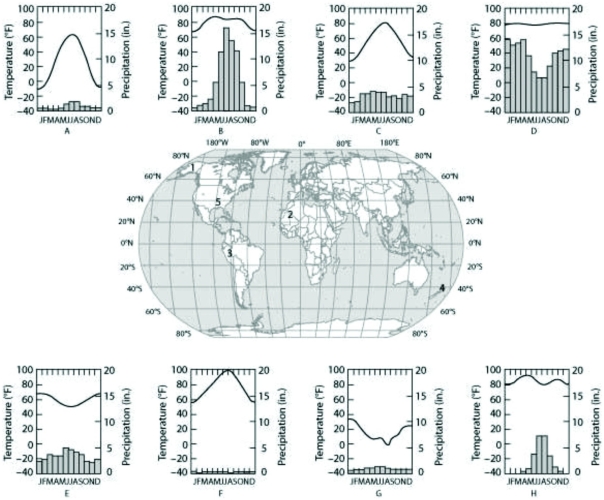 Which panel (A-H) most likely depicts the climate for location 1 as shown on the map in the center panel?
Which panel (A-H) most likely depicts the climate for location 1 as shown on the map in the center panel?
A) A
B) C
C) E
D) H
 Which panel (A-H) most likely depicts the climate for location 1 as shown on the map in the center panel?
Which panel (A-H) most likely depicts the climate for location 1 as shown on the map in the center panel?A) A
B) C
C) E
D) H

Unlock Deck
Unlock for access to all 71 flashcards in this deck.
Unlock Deck
k this deck
36
Which of the following biomes spans a large annual mean temperature range and the narrowest mean precipitation range?
A) tropical forest
B) temperate forest
C) desert
D) taiga
A) tropical forest
B) temperate forest
C) desert
D) taiga

Unlock Deck
Unlock for access to all 71 flashcards in this deck.
Unlock Deck
k this deck
37
The eight panels below show average climatic values across the year on a monthly basis, as represented by first letter of each month depicted on the x-axis. Temperature values are depicted as a line graph and represented by the left vertical axis, while precipitation values are depicted as a bar graph and represented by the right vertical axis. 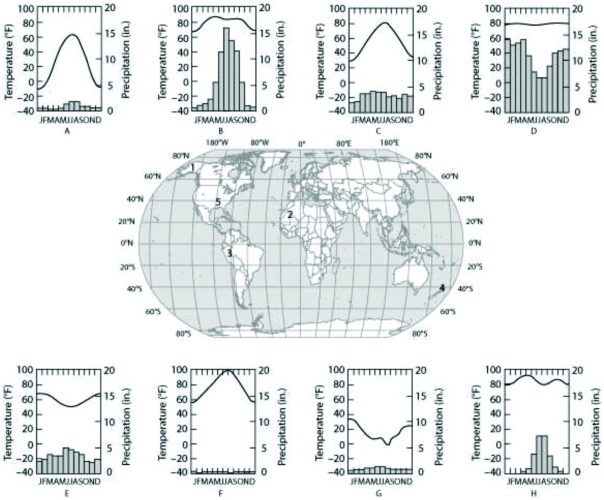 Which panel (A-H) most likely depicts the climate for location 3 as shown on the map in the center panel?
Which panel (A-H) most likely depicts the climate for location 3 as shown on the map in the center panel?
A) B
B) C
C) G
D) D
 Which panel (A-H) most likely depicts the climate for location 3 as shown on the map in the center panel?
Which panel (A-H) most likely depicts the climate for location 3 as shown on the map in the center panel?A) B
B) C
C) G
D) D

Unlock Deck
Unlock for access to all 71 flashcards in this deck.
Unlock Deck
k this deck
38
If global warming continues at its present rate, which biomes will most likely replace portions of the coniferous forest (taiga)?
A) temperate broadleaf forest and grassland
B) desert and chaparral
C) tropical forest and savanna
D) chaparral and temperate broadleaf forest
A) temperate broadleaf forest and grassland
B) desert and chaparral
C) tropical forest and savanna
D) chaparral and temperate broadleaf forest

Unlock Deck
Unlock for access to all 71 flashcards in this deck.
Unlock Deck
k this deck
39
In areas of permafrost, stands of black spruce are frequently observed in the landscape, while other tree species are noticeably absent. Often these stands are referred to as "drunken forests" because many of the black spruce often "lean over" (that is, they are displaced from their normal vertical alignment). Which of the following best explains the unusual growth of these forests in this marginal habitat?
A) Branches are adapted to absorb more carbon dioxide with this displaced alignment.
B) Taproot formation is impossible, so trees developed shallow root beds.
C) Trees are tilted so snow prevents them from breaking or tipping over.
D) Trees tip so that they do not compete with each other for sunlight.
A) Branches are adapted to absorb more carbon dioxide with this displaced alignment.
B) Taproot formation is impossible, so trees developed shallow root beds.
C) Trees are tilted so snow prevents them from breaking or tipping over.
D) Trees tip so that they do not compete with each other for sunlight.

Unlock Deck
Unlock for access to all 71 flashcards in this deck.
Unlock Deck
k this deck
40
Use the following figures to answer the question below. The diagram is a climograph, which depicts the most likely overlap between mean temperatures and precipitation values that result in the given types of biomes. 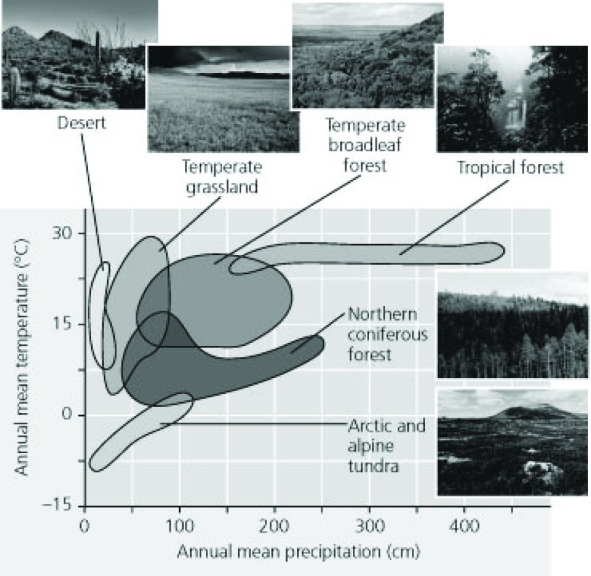 East of the Mississippi River in Hopkinsville, Kentucky, the mean annual precipitation is 130cm. The mean annual temperature is 14.3°C. In the winter, the mean temperature is 7.3°C, while in summer it is 20.6°C. Using the climograph shown here, the biome found in Hopkinsville is most likely a ________.
East of the Mississippi River in Hopkinsville, Kentucky, the mean annual precipitation is 130cm. The mean annual temperature is 14.3°C. In the winter, the mean temperature is 7.3°C, while in summer it is 20.6°C. Using the climograph shown here, the biome found in Hopkinsville is most likely a ________.
A) temperate rainforest
B) temperate broadleaf forest
C) shrubland during the winter, temperate forest during the summer
D) temperate forest during the winter, tropical seasonal forest during the summer
 East of the Mississippi River in Hopkinsville, Kentucky, the mean annual precipitation is 130cm. The mean annual temperature is 14.3°C. In the winter, the mean temperature is 7.3°C, while in summer it is 20.6°C. Using the climograph shown here, the biome found in Hopkinsville is most likely a ________.
East of the Mississippi River in Hopkinsville, Kentucky, the mean annual precipitation is 130cm. The mean annual temperature is 14.3°C. In the winter, the mean temperature is 7.3°C, while in summer it is 20.6°C. Using the climograph shown here, the biome found in Hopkinsville is most likely a ________.A) temperate rainforest
B) temperate broadleaf forest
C) shrubland during the winter, temperate forest during the summer
D) temperate forest during the winter, tropical seasonal forest during the summer

Unlock Deck
Unlock for access to all 71 flashcards in this deck.
Unlock Deck
k this deck
41
Turnover of water in temperate lakes during the spring and fall is caused by which of the following?
A) warm, less dense water layered at the top
B) cold, more dense water layered at the bottom
C) a distinct thermocline between less dense, warm water and cold, dense water
D) the changes in the density of water as seasonal temperatures change
A) warm, less dense water layered at the top
B) cold, more dense water layered at the bottom
C) a distinct thermocline between less dense, warm water and cold, dense water
D) the changes in the density of water as seasonal temperatures change

Unlock Deck
Unlock for access to all 71 flashcards in this deck.
Unlock Deck
k this deck
42
Which aquatic biome listed here is one of the most productive on Earth, and why?
A) deep-sea vent, warm water temperatures
B) coral reef, diversity of organisms
C) grasslands, nutrient rich low-moisture soils
D) oligotrophic lake, clear water for light penetration
A) deep-sea vent, warm water temperatures
B) coral reef, diversity of organisms
C) grasslands, nutrient rich low-moisture soils
D) oligotrophic lake, clear water for light penetration

Unlock Deck
Unlock for access to all 71 flashcards in this deck.
Unlock Deck
k this deck
43
In deep water, which of the following abiotic factors would most limit primary productivity?
A) temperature
B) light availability
C) solute concentration
D) chemical composition of the sea floor
A) temperature
B) light availability
C) solute concentration
D) chemical composition of the sea floor

Unlock Deck
Unlock for access to all 71 flashcards in this deck.
Unlock Deck
k this deck
44
Use the following figure to answer the question below. 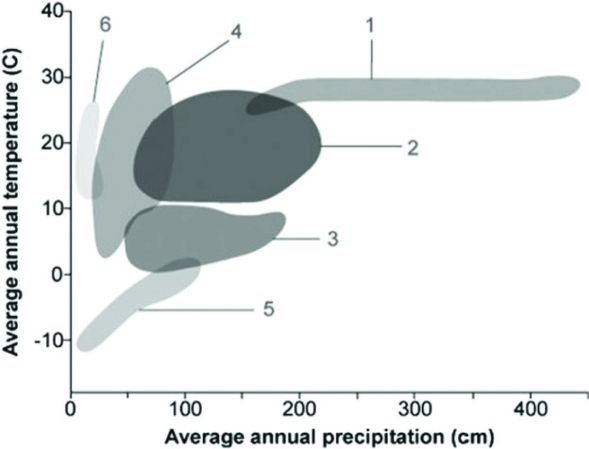 In the figure, which shaded region is the most representative of the arctic tundra biome?
In the figure, which shaded region is the most representative of the arctic tundra biome?
A) 2
B) 3
C) 4
D) 5
 In the figure, which shaded region is the most representative of the arctic tundra biome?
In the figure, which shaded region is the most representative of the arctic tundra biome?A) 2
B) 3
C) 4
D) 5

Unlock Deck
Unlock for access to all 71 flashcards in this deck.
Unlock Deck
k this deck
45
Which of the following biomes has the lowest number of vertical strata?
A) tundra
B) savanna
C) temperate broadleaf forest
D) temperate grassland
A) tundra
B) savanna
C) temperate broadleaf forest
D) temperate grassland

Unlock Deck
Unlock for access to all 71 flashcards in this deck.
Unlock Deck
k this deck
46
Studying species transplant can allow an ecologist to ________.
A) determine the distribution of a species in a specified area
B) develop mathematical models for distribution and abundance of organisms
C) determine if dispersal is a key factor in limiting distribution of organisms
D) consolidate a landscape region into a single ecosystem
A) determine the distribution of a species in a specified area
B) develop mathematical models for distribution and abundance of organisms
C) determine if dispersal is a key factor in limiting distribution of organisms
D) consolidate a landscape region into a single ecosystem

Unlock Deck
Unlock for access to all 71 flashcards in this deck.
Unlock Deck
k this deck
47
Which of the following lakes is most likely to have a relatively simple community structure and clear water?
A) an oligotrophic lake
B) a eutrophic lake
C) a relatively shallow lake
D) a nutrient-rich lake
A) an oligotrophic lake
B) a eutrophic lake
C) a relatively shallow lake
D) a nutrient-rich lake

Unlock Deck
Unlock for access to all 71 flashcards in this deck.
Unlock Deck
k this deck
48
Which of the following is a mechanism by which ocean ecosystems affect the biosphere?
A) producing a substantial amount of the biosphere's oxygen and being the source of most of Earth's rainfall
B) adding carbon dioxide to the atmosphere
C) absorbing more oxygen than is produced regulating the pH of freshwater biomes
D) allowing temperatures on continental coastlines to fluctuate widely
A) producing a substantial amount of the biosphere's oxygen and being the source of most of Earth's rainfall
B) adding carbon dioxide to the atmosphere
C) absorbing more oxygen than is produced regulating the pH of freshwater biomes
D) allowing temperatures on continental coastlines to fluctuate widely

Unlock Deck
Unlock for access to all 71 flashcards in this deck.
Unlock Deck
k this deck
49
Which of the following types of organisms is likely to have the widest global distribution?
A) bacteria
B) songbirds
C) bears
D) lizards
A) bacteria
B) songbirds
C) bears
D) lizards

Unlock Deck
Unlock for access to all 71 flashcards in this deck.
Unlock Deck
k this deck
50
Which of the following is responsible for the differences in summer and winter temperature stratification of deep temperate zone lakes?
A) Water is most dense at 4°C.
B) Oxygen is most abundant in deeper waters.
C) Winter ice sinks in the summer.
D) Stratification is caused by a thermocline.
A) Water is most dense at 4°C.
B) Oxygen is most abundant in deeper waters.
C) Winter ice sinks in the summer.
D) Stratification is caused by a thermocline.

Unlock Deck
Unlock for access to all 71 flashcards in this deck.
Unlock Deck
k this deck
51
A certain species of pine tree survives only in scattered locations at elevations above 2,800 meters in the western United States. To understand why this tree grows only in these specific places, an ecologist should ________.
A) study the anatomy and physiology of this species
B) investigate the various biotic and abiotic factors that are unique to high altitude
C) analyze the soils found in the vicinity of these trees, looking for unique chemicals that may support their growth
D) collect data on temperature, wind, and precipitation at several of these locations for a year
A) study the anatomy and physiology of this species
B) investigate the various biotic and abiotic factors that are unique to high altitude
C) analyze the soils found in the vicinity of these trees, looking for unique chemicals that may support their growth
D) collect data on temperature, wind, and precipitation at several of these locations for a year

Unlock Deck
Unlock for access to all 71 flashcards in this deck.
Unlock Deck
k this deck
52
Which of the following biotic or abiotic factors limit(s) the range of Saguaro cactus in North America?
A) pollinators
B) precipitation and temperature
C) sunlight
D) all of the above
A) pollinators
B) precipitation and temperature
C) sunlight
D) all of the above

Unlock Deck
Unlock for access to all 71 flashcards in this deck.
Unlock Deck
k this deck
53
Which of the following statements about light in aquatic environments is the most accurate?
A) Water equally reflects and absorbs all wavelengths of light.
B) Longer wavelengths penetrate to greater depths.
C) Light penetration largely limits the distribution of photosynthetic species.
D) Most photosynthetic organisms avoid the surface where the light is too intense.
A) Water equally reflects and absorbs all wavelengths of light.
B) Longer wavelengths penetrate to greater depths.
C) Light penetration largely limits the distribution of photosynthetic species.
D) Most photosynthetic organisms avoid the surface where the light is too intense.

Unlock Deck
Unlock for access to all 71 flashcards in this deck.
Unlock Deck
k this deck
54
If a deep temperate zone lake did not turn over during the spring and fall seasons as they normally do, which of the following conditions is most likely to result?
A) The lake would fail to freeze over in winter.
B) An algal bloom of algae would result every spring.
C) Lakes would suffer a nutrient depletion in surface layers.
D) The pH of the lake would become increasingly alkaline.
A) The lake would fail to freeze over in winter.
B) An algal bloom of algae would result every spring.
C) Lakes would suffer a nutrient depletion in surface layers.
D) The pH of the lake would become increasingly alkaline.

Unlock Deck
Unlock for access to all 71 flashcards in this deck.
Unlock Deck
k this deck
55
Which of these environmental factors has the largest control over the biotic structure of aquatic biomes?
A) average annual air temperature
B) seasonal fluctuation of water temperature
C) oxygen concentrations, salinity, and nutrient levels
D) average annual precipitation
A) average annual air temperature
B) seasonal fluctuation of water temperature
C) oxygen concentrations, salinity, and nutrient levels
D) average annual precipitation

Unlock Deck
Unlock for access to all 71 flashcards in this deck.
Unlock Deck
k this deck
56
Which of the following environmental conditions poses/presents the strongest physiological challenge for a fish swimming into an estuary from a river?
A) The high water flow would make the fish expend more energy.
B) The low oxygen content would give the fish difficulty in swimming aerobically.
C) The temperature change would stress the fish by denaturing its proteins.
D) The change in water solute content would challenge the osmotic balance of the fish.
A) The high water flow would make the fish expend more energy.
B) The low oxygen content would give the fish difficulty in swimming aerobically.
C) The temperature change would stress the fish by denaturing its proteins.
D) The change in water solute content would challenge the osmotic balance of the fish.

Unlock Deck
Unlock for access to all 71 flashcards in this deck.
Unlock Deck
k this deck
57
Which of the following statements regarding turnover in a lake is the most accurate?
A) In fall turnover, dense water at 4°C sinks and disturbs sediments in the benthic zone.
B) In fall turnover, dense water at 4°C rises and disturbs sediments in the benthic zone.
C) The surface water gets to 4°C only by cooling.
D) Fall turnovers and spring turnovers are exactly the same.
A) In fall turnover, dense water at 4°C sinks and disturbs sediments in the benthic zone.
B) In fall turnover, dense water at 4°C rises and disturbs sediments in the benthic zone.
C) The surface water gets to 4°C only by cooling.
D) Fall turnovers and spring turnovers are exactly the same.

Unlock Deck
Unlock for access to all 71 flashcards in this deck.
Unlock Deck
k this deck
58
Use the following figure to answer the question below. The shaded regions represent the expected climate conditions which give rise to the particular biomes. 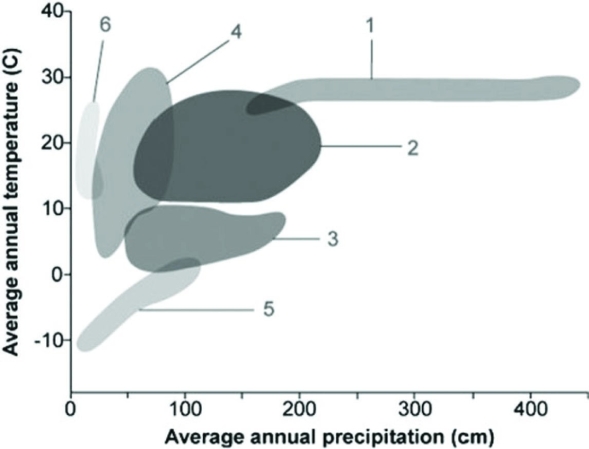 Which shaded region in the figure is the most representative of the biome with the highest variation in annual temperature?
Which shaded region in the figure is the most representative of the biome with the highest variation in annual temperature?
A) 1
B) 2
C) 3
D) 4
 Which shaded region in the figure is the most representative of the biome with the highest variation in annual temperature?
Which shaded region in the figure is the most representative of the biome with the highest variation in annual temperature?A) 1
B) 2
C) 3
D) 4

Unlock Deck
Unlock for access to all 71 flashcards in this deck.
Unlock Deck
k this deck
59
Two evolutionarily unrelated plant species may live within the same type of biome but on different continents. Which of the following mechanisms would most likely result in these two species having similar traits?
A) convergent evolution
B) allopatric speciation
C) introgression
D) gene flow
A) convergent evolution
B) allopatric speciation
C) introgression
D) gene flow

Unlock Deck
Unlock for access to all 71 flashcards in this deck.
Unlock Deck
k this deck
60
Use the following figure to answer the question below. The shaded regions represent the expected climate conditions which give rise to the particular biomes. 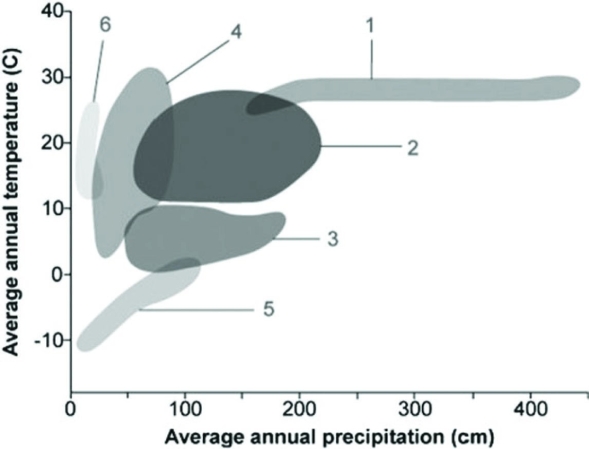 Which shaded region in the figure is the most representative of the biome with the highest variation in annual precipitation?
Which shaded region in the figure is the most representative of the biome with the highest variation in annual precipitation?
A) 1
B) 2
C) 3
D) 4
 Which shaded region in the figure is the most representative of the biome with the highest variation in annual precipitation?
Which shaded region in the figure is the most representative of the biome with the highest variation in annual precipitation?A) 1
B) 2
C) 3
D) 4

Unlock Deck
Unlock for access to all 71 flashcards in this deck.
Unlock Deck
k this deck
61
If the direction of Earth's rotation reversed, the most predictable effect would be ________.
A) a big change in the length of the year
B) winds blowing from west to east along the equator
C) a loss of seasonal variation at high latitudes
D) the elimination of ocean currents
A) a big change in the length of the year
B) winds blowing from west to east along the equator
C) a loss of seasonal variation at high latitudes
D) the elimination of ocean currents

Unlock Deck
Unlock for access to all 71 flashcards in this deck.
Unlock Deck
k this deck
62
Which of the following examples demonstrates an ecological effect leading to an evolutionary effect?
A) When seeds are not plentiful, trees produce more seeds.
B) A few individuals with denser fur than the population average survive the coldest years of an ice age, and the offspring of the reproducing survivors of the ice age will likely have more dense fur.
C) Fish that swim the fastest in running water catch the most prey and more easily escape predation.
D) The insects that spend the most time exposed to sunlight have the most mutations from UV light, and thus evolve the fastest
A) When seeds are not plentiful, trees produce more seeds.
B) A few individuals with denser fur than the population average survive the coldest years of an ice age, and the offspring of the reproducing survivors of the ice age will likely have more dense fur.
C) Fish that swim the fastest in running water catch the most prey and more easily escape predation.
D) The insects that spend the most time exposed to sunlight have the most mutations from UV light, and thus evolve the fastest

Unlock Deck
Unlock for access to all 71 flashcards in this deck.
Unlock Deck
k this deck
63
Which statement about dispersal is false?
A) Dispersal is a common component of the life cycles of plants and animals.
B) Colonization of devastated areas after floods or volcanic eruptions depends on dispersal.
C) Dispersal occurs only on an evolutionary time scale.
D) The ability to disperse can expand the geographic distribution of a species.
A) Dispersal is a common component of the life cycles of plants and animals.
B) Colonization of devastated areas after floods or volcanic eruptions depends on dispersal.
C) Dispersal occurs only on an evolutionary time scale.
D) The ability to disperse can expand the geographic distribution of a species.

Unlock Deck
Unlock for access to all 71 flashcards in this deck.
Unlock Deck
k this deck
64
The oceans affect the biosphere in all of the following ways except ________.
A) producing a substantial amount of the biosphere's oxygen
B) removing carbon dioxide from the atmosphere
C) moderating the climate of terrestrial biomes
D) regulating the pH of freshwater biomes and terrestrial groundwater
A) producing a substantial amount of the biosphere's oxygen
B) removing carbon dioxide from the atmosphere
C) moderating the climate of terrestrial biomes
D) regulating the pH of freshwater biomes and terrestrial groundwater

Unlock Deck
Unlock for access to all 71 flashcards in this deck.
Unlock Deck
k this deck
65
Which statement about dispersal is the most accurate?
A) Dispersal is a common component of the life cycles of plants and animals.
B) Colonization of devastated areas after floods or volcanic eruptions does not depend upon climate.
C) Root growth is the most important mode of dispersal in the life cycles of flowering plants.
D) Dispersal occurs only on an evolutionary time scale.
A) Dispersal is a common component of the life cycles of plants and animals.
B) Colonization of devastated areas after floods or volcanic eruptions does not depend upon climate.
C) Root growth is the most important mode of dispersal in the life cycles of flowering plants.
D) Dispersal occurs only on an evolutionary time scale.

Unlock Deck
Unlock for access to all 71 flashcards in this deck.
Unlock Deck
k this deck
66
Suppose that the number of bird species is determined mainly by the number of vertical strata found in the environment. If so, in which of the following biomes would you find the greatest number of bird species?
A) tropical rain forest
B) savanna
C) desert
D) temperate broadleaf forest
A) tropical rain forest
B) savanna
C) desert
D) temperate broadleaf forest

Unlock Deck
Unlock for access to all 71 flashcards in this deck.
Unlock Deck
k this deck
67
Which of the following areas of study focuses on the exchange of energy, organisms, and materials between ecosystems?
A) organismal ecology
B) landscape ecology
C) ecosystem ecology
D) community ecology
A) organismal ecology
B) landscape ecology
C) ecosystem ecology
D) community ecology

Unlock Deck
Unlock for access to all 71 flashcards in this deck.
Unlock Deck
k this deck
68
Use the diagram showing the spread of the cattle egret, Bubulcus ibis, since its arrival in the New World, to answer the question. The range of cattle egrets has expanded between 1937 (dark region in South America) and today, as depicted in the map with lighter shades indicating more recent advancements of the egret over time. 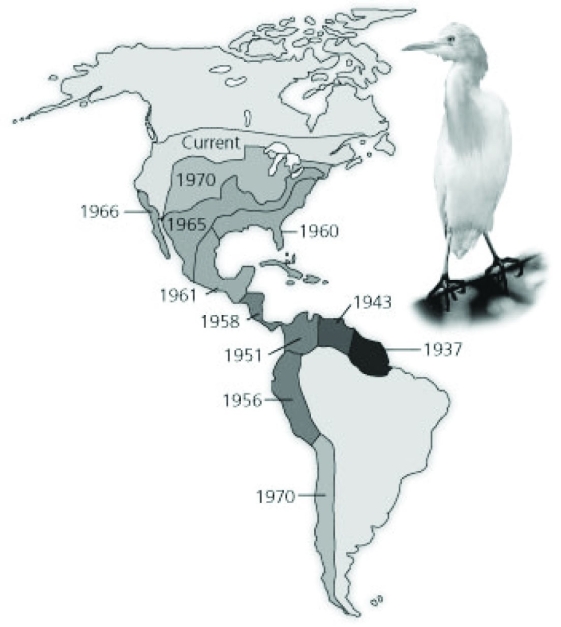 Which of the following claims best explains the expansion of the cattle egret range?
Which of the following claims best explains the expansion of the cattle egret range?
A) Climatic factors, such as sunlight, temperature, and precipitation, provide a suitable habitat for cattle egrets.
B) There are no predators for cattle egrets in the New World, so they continue to expand their range.
C) The abundant area and little competition with other birds occupying similar habitats met the biotic and abiotic requirements of the cattle egret expansion.
D) The first egrets to colonize South America evolved into a new species capable of competing with the native species of herons and egrets.
 Which of the following claims best explains the expansion of the cattle egret range?
Which of the following claims best explains the expansion of the cattle egret range?A) Climatic factors, such as sunlight, temperature, and precipitation, provide a suitable habitat for cattle egrets.
B) There are no predators for cattle egrets in the New World, so they continue to expand their range.
C) The abundant area and little competition with other birds occupying similar habitats met the biotic and abiotic requirements of the cattle egret expansion.
D) The first egrets to colonize South America evolved into a new species capable of competing with the native species of herons and egrets.

Unlock Deck
Unlock for access to all 71 flashcards in this deck.
Unlock Deck
k this deck
69
When climbing a mountain, we can observe transitions in biological communities that are analogous to the changes ________.
A) in biomes at different latitudes
B) in different depths in the ocean
C) in a community through different seasons
D) in an ecosystem as it evolves over time
A) in biomes at different latitudes
B) in different depths in the ocean
C) in a community through different seasons
D) in an ecosystem as it evolves over time

Unlock Deck
Unlock for access to all 71 flashcards in this deck.
Unlock Deck
k this deck
70
Which lake zone would be absent in a very shallow lake?
A) benthic zone
B) aphotic zone
C) pelagic zone
D) littoral zone
A) benthic zone
B) aphotic zone
C) pelagic zone
D) littoral zone

Unlock Deck
Unlock for access to all 71 flashcards in this deck.
Unlock Deck
k this deck
71
Which of the following is characteristic of most terrestrial biomes?
A) a distribution predicted almost entirely by rock and soil patterns
B) clear boundaries between adjacent biomes
C) vegetation demonstrating vertical layering
D) cold winter months
A) a distribution predicted almost entirely by rock and soil patterns
B) clear boundaries between adjacent biomes
C) vegetation demonstrating vertical layering
D) cold winter months

Unlock Deck
Unlock for access to all 71 flashcards in this deck.
Unlock Deck
k this deck



